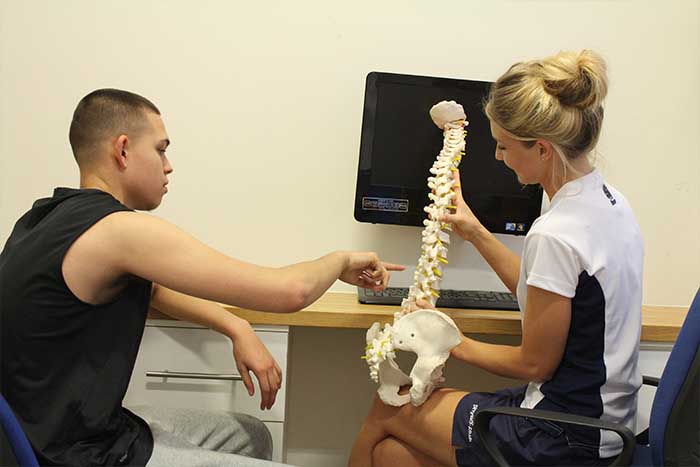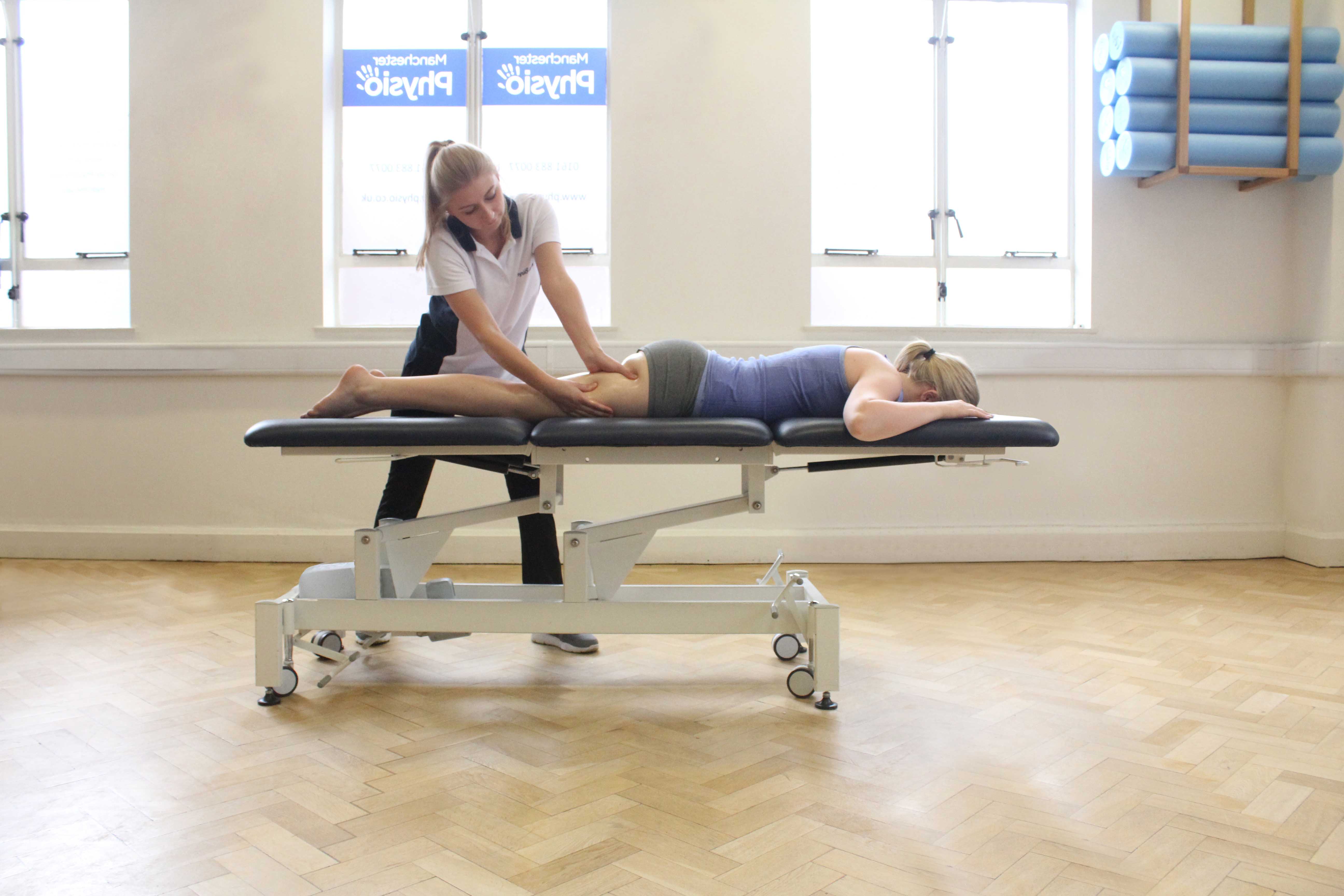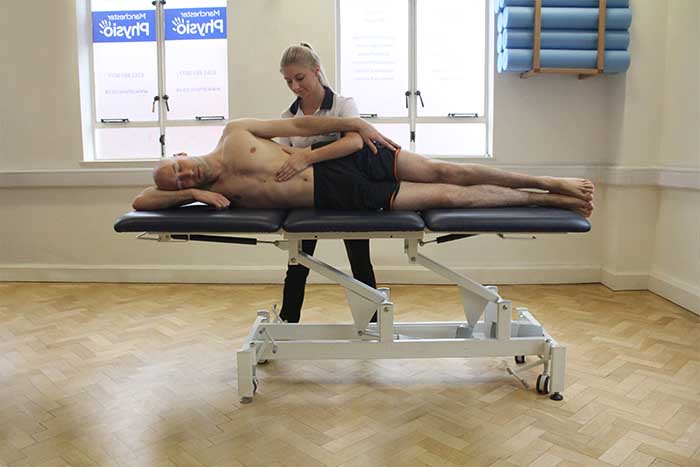Massage is an important modality for any individual taking part in sport whether it is competitive or recreational. Regardless of sporting ability, massage has the ability to reduce pain, tension and tightness, promote healing and improve recovery which together can maintain or improve sporting performance. Massage is also used readily to reduce the risk of injury because tight muscles lacking flexibility and elasticity can be susceptible to tears during the demands of sport. Multiple massage techniques can be used which can alter in speed and direction to manipulate the soft tissue in concern.

What is massage for sports people?
Massage as a treatment modality can target a number of physiological issues commonly experienced by sporting individuals. Physiological issues experienced by sports people include delayed onset of muscle soreness (DOMS), tight muscles and poor flexibility. If an individual does not prepare and manage their muscles effectively, before and after exercise, their performance can be inhibited. Massage is used by athletes to maintain muscular flexibility, elasticity, range of movement and performance while reducing their risk of injury.
When can massage help sports people?
Massage therapy can be used as treatment modality in a range of circumstances such as;
 Above: Soft tissue massage applied to the hamstring muscles following sports
Above: Soft tissue massage applied to the hamstring muscles following sportsPre-event massage refers to massage applied to the individual prior to exercise, be it a sporting competition, a marathon or general workout. During pre-event massage fast techniques such as tapotement and light petrissage are used to invigorate and excite the muscles enabling them to prepare for physical activity. Through the stretching of the muscle fibres and the increase in blood supply the massage can improve muscular performance via the improved muscular flexibility. An increase in muscular flexibility can reduce the right amount of injury. Pre-event massage can also enable the sports person to mentally prepare for physical activity by enabling the athlete to psych themselves up and enter the ultimate mind set during the massage.
Post-event massage refers to massage applied to the individual following a sporting or physical activity. Post-event massage aims to relax the muscle and assist in recovery, healing and waste removal. Effleurage, petrissage, lymphatic drainage and myofascial release are all massage techniques that can be used following exercise. Light to moderate massage techniques promote relaxation within the muscles while assisting the lymphatic system to remove the waste products produced during exercise. A post-event massage will enable the individual to recover quickly and feel a reduction in pain, muscular tightness and muscular fatigue.
Massage included within a training programme can include techniques such as effleurage, petrissage, myofascial release, lymphatic drainage and trigger point therapy. The aim of massage when applied during a training programme is to improve or maintain muscular flexibility, elasticity and performance. When massage is received regularly it can maintain the health of working muscles by increasing blood circulation carrying oxygen and nutrients to the tissues. Overall, massage applied during a training programme can improve sporting performance, reduce the risk of injury and improve the health of muscles.
Massage therapy can be used to ease the pain associated with delayed onset of muscle soreness (DOMS) which is a soreness typically felt 24 to 48 hours following physical activity. DOMS is the result of multiple microscopic traumas to the muscle fibres involved in exercise. Massage such as effleurage, petrissage and lymphatic drainage is extremely beneficial to an individual suffering from DOMS due to the ability to decrease pain and stiffness and promote recovery and healing.
Massage therapy can also be used specifically to target and relieve tight muscles. Massage techniques such as effleurage, petrissage, myofascial release, trigger point therapy and frictions can all be used to relieve muscle tightness. A reduction in muscular tightness is achieved by promoting relaxation and decreasing the presence of scar tissue and adhesive fibre connections. A reduction in muscular tightness can result in improved flexibility, elasticity and performance and decreased pain.
What are the physiological effects of a massage for sports people?
The application of massage can produce a number of physiological effects to the individual's tissues. The physiological effects of massage include;
Massage can increase capillarisation. Capillarisation refers to an increase in the number of capillaries surrounding muscles. Capillaries are small blood vessels responsible for transferring blood to and from tissues containing oxygen and waste products. An increase in capillaries can produce an increase in blood circulation, meaning an increase in the deliverance of oxygen and nutrients to the muscle which improves their condition. With reference to sporting performance, capillarisation can enable the muscle to work harder for longer without experiencing fatigue.
Massage can increase cellular exchange. Cellular exchange refers to the removal of waste products from tissues and the deliverance of oxygen and nutrients to tissues. Massage can stimulate an increase in cellular exchange by increasing blood circulation. An increase in blood circulation is achieved by vasodilation, a process where smooth muscles surrounding blood vessels relax allowing the vessels to widen. An increase in cellular exchange can improve or maintain healthy muscles, improve healing and recovery and decrease pain.
Massage can breakdown/realign collagen fibres. Following vigorous exercise, the worked muscles experience microscopic tears. Microscopic tears within muscles are repaired using collagen fibres which are laid down in an unorganised fashion with adhesive cross fibre connections. Adhesive fibre connections can cause a tissue to become tense, inflexible and dysfunctional. Massage can breakdown and realign adhesive collagen fibres through the application of pressure and manipulation. Once a breakdown/ realignment of collagen fibres is a achieved the muscle will increase in elasticity, flexibility, performance and a reduction in pain and muscular tension will be experienced.

What are the benefits of a massage for sports people?
Massage should play an important factor in the routine of any sportsmen or women as massage can produce multiple physiological and psychological benefits which include:
Massage is used to increase muscle flexibility, this is achieved through the application of moderate to deep massage techniques. Massage can increase flexibility by increasing the temperature of tissues and decreasing muscular tension. An increase in tissue temperature is achieved through an increase in blood circulation during the process of vasodilation. A decrease in muscular tension is achieved through breaking down and realigning adhesive collagen fibres. An increase in muscular flexibility can also improve range of movement, maximise performance and prevent injury.
Massage can be used to improve an individual's range of movement. Having a large range of movement is essential in sport to reduce the risk of injury and maximise performance. Range of movement can be increased by increasing tissue temperature and muscular elasticity and decreasing scar tissue. An increase in temperature is achieved through vasodilation which results in an increase in blood circulation to warm the tissues. By increasing the temperature of the muscle it will become more relaxed and increase in elasticity. A reduction in scar tissue is achieved by applying manipulative techniques which can breakdown the adhesive collagen fibre connections. An increase in range of movement can maximise sporting performance, reduce the chance of injury and improve tissues flexibility.
Massage can be used to relieve muscular tension which is a common symptom experienced by sporting individuals. Muscular tension can occur following vigorous exercise due to the buildup of waste products and scar tissue. Massage can assist in the removal of waste products from tissues through lymphatic drainage techniques. Lymphatic drainage techniques help push lymphatic fluid containing waste products and toxins towards lymph nodes where the fluid can be filtered and expelled from the body. Massage can decrease the presence of scar tissue by breaking up adhesive fibre connections and realigning disorganised collagen fibres. A decrease in muscular tension can also improve tissue flexibility and performance while decreasing pain.
Massage therapy can be used to maximise sporting performance by producing a number of benefits such as a reduction in pain and an improvement in muscular flexibility, range of motion and psychological state of mind. A range of massage techniques can be applied which differ in depth, speed and direction to enhance muscular performance. A range of physiological effects can improve sporting performance such as increased tissue temperature, elasticity and flexibility and a breakdown and realignment of collagen fibres.
Massage therapy can also be used to prevent injury while participating or competing in sporting activities. Injury is common in sport due to the excessive strain placed upon an individual's body. Massage therapy can prevent injury occurring by increasing muscular flexibility and decreasing scar tissue. An increase in flexibility is achieved by increasing the temperature of the tissue allowing it to relax and become more pliable. A decrease in scar tissue is achieved through applying deep manipulative strokes which can break up the adhesive cross fibre connections of scar tissue.
Summary
Massage treatment is valuable to sports people due to the vast number of benefits which can be achieved following the application of massage. Specific circumstances where massage can be extremely beneficial to sports people include pre-event, post-event, part of a training programme, delayed onset of muscle soreness and tight muscles. The benefits of massage include an increase in flexibility, range of movement and performance and a decrease in tension, in addition to injury prevention. The benefits of massage are achieved through producing a number of physiological effects with massage such as increased capillarisation, cellular exchange and the breakdown/ realignment of collagen fibres.
How can I arrange a massage for sports people?
To arrange a massage to help Sports People at Physio.co.uk, email us at office@physio.co.uk or call us on 0161 883 0077.
You can also book an appointment online and save £10.

 0330 088 7800
0330 088 7800



































